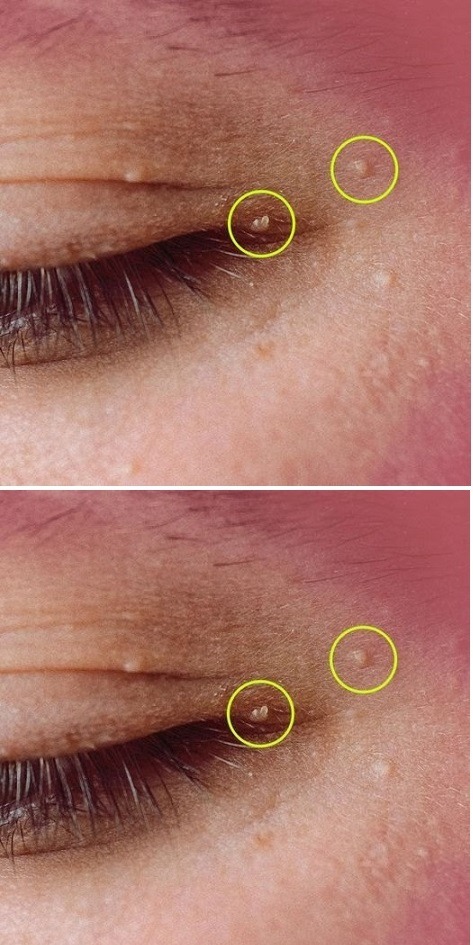How to Get Rid of Milia: Those Annoying Fat Cysts
How to Get Rid of Milia: A Step-by-Step Guide to Banish Those Annoying Fat Cysts
Milia are tiny, white or yellowish pimples that typically show up on the forehead, cheeks, or eyes. These lumps, which are frequently referred to as “fat cysts,” are actually microscopic cysts packed with keratin that are trapped beneath the skin’s surface. Even though milia are benign, they can undermine your confidence and be annoying to deal with. Fortunately, there are safe and efficient methods for getting rid of them at home. Here is a comprehensive guide to help you deal with milia step-by-step.
What Are Milia?
Milia form when keratin (a protein in skin, hair, and nails) becomes trapped beneath the outer layer of the skin. Unlike pimples, milia are not caused by clogged pores or bacteria, and they cannot be “popped” like traditional acne. Milia can occur at any age and are often triggered by factors such as:
- Excessive sun exposure
- Heavy skincare products that block pores
- Skin trauma or irritation
- Natural buildup of dead skin cells
How to Get Rid of Milia Step by Step
Step 1: Cleanse Your Skin
Start with a clean slate to prepare your skin for treatment.
- Use a gentle cleanser: Opt for a mild, non-comedogenic cleanser that won’t clog your pores. Look for ingredients like glycerin or ceramides to hydrate while cleansing.
- Wash with lukewarm water: Avoid hot water, as it can irritate your skin and exacerbate milia.
- Pat your skin dry: Use a soft towel to gently pat (not rub) your skin dry.
Step 2: Exfoliate Regularly
Exfoliation helps remove dead skin cells that could trap keratin and form milia.
- Choose a chemical exfoliant: Look for products containing alpha-hydroxy acids (AHAs) like glycolic acid or beta-hydroxy acids (BHAs) like salicylic acid. These gently dissolve dead skin cells without scrubbing.
- Use exfoliants 1-2 times a week: Over-exfoliating can irritate your skin, so stick to a moderate routine.
- Avoid physical scrubs: Harsh scrubs can damage the skin and worsen milia, especially in sensitive areas like around the eyes.
Step 3: Steam Your Face
Facial steaming helps open up your pores and softens the skin, making it easier to remove milia.
- Boil water and pour it into a bowl: Let it cool slightly to avoid burns.
- Drape a towel over your head: Lean over the bowl and create a tent with the towel to trap the steam.
- Steam for 5-10 minutes: This softens the top layer of your skin, making the extraction process safer and more effective.
Step 4: Apply a Retinoid Cream
Retinoids are derived from vitamin A and can help speed up cell turnover, reducing the formation of milia.
- Choose an over-the-counter retinoid: Look for products with adapalene or retinol.
- Apply a pea-sized amount: Use this sparingly, as retinoids can cause dryness or irritation if overused.
- Use at night: Retinoids make your skin more sensitive to sunlight, so apply them as part of your nighttime skincare routine.
Step 5: Try a Milia Removal Tool
If you feel confident, you can attempt to extract milia with the right tools. This step is optional and should be done with caution.
- Sterilize a comedone extractor: Use rubbing alcohol to clean the tool thoroughly.
- Gently press around the milia: Place the loop of the extractor over the milia and apply light pressure. If the cyst doesn’t come out easily, stop to avoid damaging your skin.
- Disinfect the area: After removal, clean the area with an antiseptic to prevent infection.
Step 6: Moisturize and Protect
Hydration is key to maintaining healthy skin and preventing future milia.
- Use a lightweight, non-comedogenic moisturizer: This helps keep your skin hydrated without clogging pores.
- Apply sunscreen daily: UV damage can exacerbate milia, so use a broad-spectrum sunscreen with at least SPF 30.
- Avoid heavy creams: Opt for gel-based or water-based products if you have oily or combination skin.
Preventing Milia
Once you’ve cleared up your skin, you can take steps to prevent milia from recurring:
- Choose the right skincare products: Avoid heavy, oil-based products that can block pores.
- Keep your skin clean: Always remove makeup before bed and wash your face twice daily.
- Use a humidifier: If you live in a dry climate, a humidifier can help keep your skin hydrated.
- Exfoliate regularly: Gentle exfoliation helps maintain smooth, clear skin.
When to See a Dermatologist
While home remedies are effective for most people, some cases of milia may require professional help. Consult a dermatologist if:
- Milia persist despite home treatments.
- They appear in large clusters or are painful.
- You’re unsure whether the bumps are milia or another skin condition.
Conclusion
Milia may be small, but they can be a source of big frustration. By following this step-by-step guide, you can safely and effectively reduce these stubborn bumps and keep them from coming back. With consistent care and the right products, you can achieve smoother, healthier skin and say goodbye to those annoying fat cysts for good!

